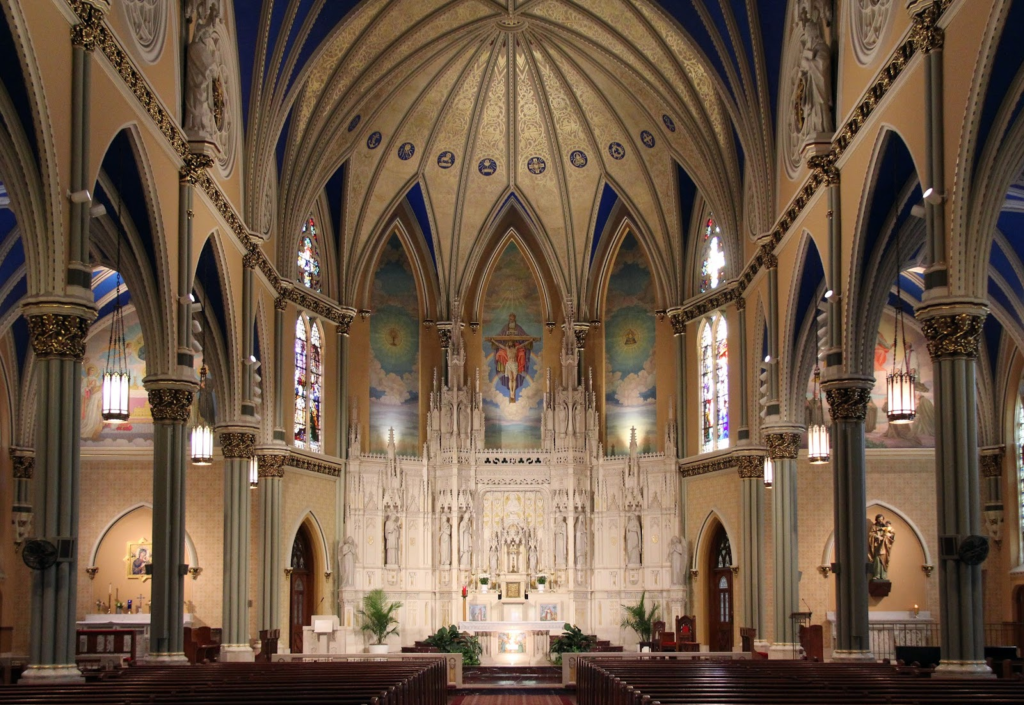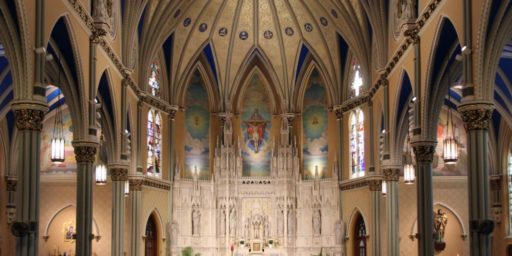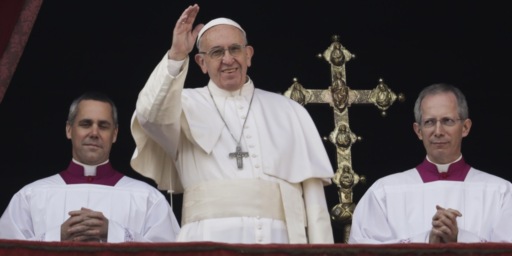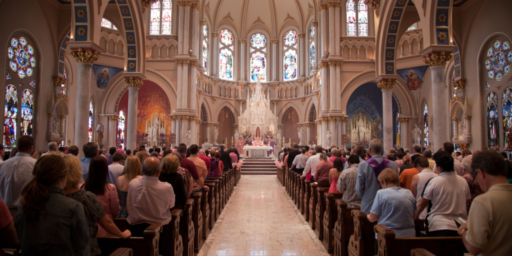500 Catholic Priests In Illinois Found To Have Abused Children, Report Says
A preliminary report from Illinois Attorney General Lisa Madigan found at least 500 Catholic Priests whose abuse of children had been covered up by Church officials.

An investigation by Illinois’s Attorney General finds that the Catholic Church covered up as many as 500 Priests who abused children:
The Catholic Church in Illinois withheld the names of at least 500 priests accused of sexual abuse of minors, the state’s attorney general said Wednesday in a scathing report that accused the church of failing victims by neglecting to investigate their allegations.
The preliminary report by Attorney General Lisa Madigan concludes that the Catholic dioceses in Illinois are incapable of investigating themselves and “will not resolve the clergy sexual abuse crisis on their own.”
The report said that 690 priests were accused of abuse, and only 185 names were made public by the dioceses as having been found credibly accused of abuse.
“The number of allegations above what was already public is shocking,” said Ms. Madigan in an interview.\
The Illinois report is only the latest effort by state prosecutors to hold the Catholic Church accountable by scrutinizing the church’s own records. At least 16 state attorneys general have initiated investigations of varying scope since August, after a devastating grand jury report in Pennsylvania accused more than 300 priests of sexual abuse over 50 years, and accused bishops of covering up.
Unlike Pennsylvania’s voluminous grand jury report, the nine-page report in Illinois does not name accused priests or call out particular bishops for negligence.
But it tries to quantify the enormous gap between the number of accusations made by victims who dared to contact the church, and the number of accusations the church deemed credible.
Three-fourths of the allegations against clergy were either not investigated, or were investigated but not substantiated by the dioceses, the report found, based on files that the dioceses turned over to the attorney general’s office.
A pattern emerged from the files in which dioceses often failed to find a claim credible if there was only one victim, the report said. They also failed to investigate at all if the accused priest was deceased or reassigned, or belonged to a religious order (such as the Franciscans, Marists or Jesuits). The dioceses often discredited survivors’ claims by “focusing on the survivors’ personal lives,” the report said
Representatives of all six dioceses in Illinois cooperated with the investigation by meeting with the attorney general and her staff, voluntarily producing thousands of documents and providing access to hundreds of clergy files related to abuse allegations, the Illinois report said.
Once the attorney general’s office began investigating, the report said, the Illinois dioceses disclosed the names of 45 more clergy who were deemed by the church to be credibly accused of abusing minors — most of them cases the dioceses knew about for years.
“I want to express again the profound regret of the whole church for our failures to address the scourge of clerical sexual abuse,” Cardinal Blase J. Cupich, the archbishop of Chicago, said in a statement. “It is the courage of victim-survivors that has shed purifying light on this dark chapter in church history.”
More from the Chicago Tribune:
A scathing report from Attorney General Lisa Madigan finds the number of Catholic priests accused of sexual abuse against children in Illinois is much higher than previously acknowledged.
The report said accusations have been leveled against 690 priests, while Catholic officials have publicly identified only 185 clergy with credible allegations against them.
The determination is part of a preliminary report made public Wednesday by Madigan’s office, which has been investigating Catholic clergy sexual abuse of minors following revelations during the summer of widespread abuse and cover-ups by Catholic officials in Pennsylvania. The report was critical of the six Catholic dioceses that govern parishes across Illinois for their lack of transparency and flawed investigations.
Although the report says that “Clergy sexual abuse of minors in Illinois is significantly more extensive than the Illinois Dioceses previously reported,” it does not estimate how many of the allegations against the 690 clergy should have been deemed credible. Some of the allegations go back decades.
The report says Illinois dioceses “have lost sight of both a key tenet” of policies laid out by the United States Conference of Catholic Bishops as well as “the most obvious human need as a result of these abhorrent acts of abuse: the healing and reconciliation of survivors.”
“Long after legal remedies have expired, the Catholic Church has the ability and moral responsibility to survivors to offer support and services, and to take swift action to remove abusive clergy,” the report states.
In a prepared statement, Chicago Cardinal Blase Cupich acknowledged that victims of sexual abuse by Catholic priests continue to live with the pain. He said the archdiocese has been looking into the issue of sexual abuse since at least 1991, when then-Cardinal Joseph Bernardin formed a special commission. He also cited the archdiocese’s Office for the Protection of Children and Youth as a way it has tried to help survivors.”I want to express again the profound regret of the whole church for our failures to address the scourge of clerical sexual abuse,” Cupich said in the statement. “It is the courage of the victim-survivors that has shed purifying light on this dark chapter in church history.”
Madigan stressed the findings issued in the report are based on a preliminary investigation, and it was too soon to say what, if any, action should be brought by her office. She said she would like to see her successor, Democrat Kwame Raoul, continue the inquiry next year.
In a statement issued Wednesday, Raoul committed to continuing the inquiry once his term begins.
(…)
The AG’s report found that in many cases, the dioceses did not conduct proper investigations into allegations, particularly when the priest had died, left the ministry or was a member of a religious order and therefore not under the authority of a diocese.
In some cases, the dioceses referred an allegation of abuse to a priest’s religious order rather than investigating the abuse themselves. In other cases, an allegation was not investigated at all if a lawsuit had been filed, if the person making the allegation wanted to remain anonymous, if a police agency was investigating the incident or if a priest had left the United States, according to the report.
Madigan’s office found instances in which the dioceses used personal information against the person making the allegation to discredit them, which then led to the accusation not being found credible. The report didn’t specify when the dioceses used such tactics.
In addition, terminology used by the various state dioceses differs, making it difficult to understand when an allegation of abuse was deemed credible. The dioceses governing the Chicago area and Joliet area were the only ones in the state that made information public about sexual abuse before the attorney general began investigating, according to the report. Last month, the Archdiocese of Chicago added 10 names to an online list of clergy with substantiated allegations of sexual abuse involving children.
It wasn’t until this fall that the other dioceses across the state made efforts to make the information public, Madigan said.
Madigan expects the list of priests accused of abusing children to grow as investigators sort through the allegations involving hundreds of priests across the state. Before the investigation began, there were about 140 Catholic priests in Illinois who had been publicly named as having sexually abused children. In the four months of the investigation, that list has already gotten longer as Madigan’s office began digging through files, she said.
The office of the attorney general created a hotline for victims of abuse, and it has already fielded 300 calls, Madigan said.
“These survivors, they are calling us recognizing that the criminal justice system may not be one where they will get relief, but they are seeking a measure of justice, they are seeking closure,” Madigan said by phone. “They are seeking an ability to move forward with their lives and a very large part of that is the church taking their allegations seriously, investigating them and acknowledging the crimes that took place, and publicly disclosing the names of the individuals who committed those crimes.”The preliminary report found that some victims of abuse who had previously come forward were never even told the results, if any, of investigations.
None of the dioceses across the state have taken steps to put in place policies to hold officials, such as Catholic bishops, responsible for covering up abuse of children, according to the report.
The Catholic Church abuse scandal, of course, has been in the news for the better parts of two decades now, with revelations about abuse in the past and the manner in which it was covered up first becoming public during the Papacy of John Paul II, who was heavily criticized at the time for the perception that he was not adequately addressing the issue. To some extent, John Paul’s successor Benedict XVI was seen as being more willing to open up church records and to cooperate with investigators around the world and, to some degree, it seemed as if the Church was finally seeing the light of day on this issue.
More recent events, though, have shown that very little has actually changed as far as the Church hierarchy and the way it approaches this issue is concerned. The most prominent example of that came in the case of Theodore McCarrick, who had served as the Bishop of Metuchen and Newark, New Jersey as well as Washington, D.C. and was later elevated to Cardinal by John Paul II. While there had been whispers about abuse allegations in McCarrick’s past, Pope Francis chose to ignore them and made McCarrick a close adviser on internal church matters. Earlier this year, though, Francis was forced to accept McCarrick’s resignation as the charges against him became public, and allegations have been made that he was aware of the Cardinals past even while bringing him into his inner circle. Additionally, it has become clear that the Pope’s rhetoric on these new revelations was largely empty, especially when a senior Vatican official alleged late last month that both Pope Francis and his predecessor Pope Emeritus Benedict XVI were aware of the allegations against McCarrick as well as other abuse allegations that were also hidden from the public. Finally, it became clear that Francis has a blind spot when it comes to the issues of sexual abuse by Catholic Priests. Earlier this year, for example, Francis came to the defense of Chilean Bishopss when they were accused of having covered up abuse in much the same manner as their fellow Bishops around the world.
In addition to the McCarrick scandal, the Church has been hit by a report issued in August by a Pennsylvania Grand Jury regarding sexual abuse by Catholic clergy in that state and the role that Church hierarchy played in covering up those reports by methods such as moving Priests from one Parish to another, or otherwise reassigning them to duties where they would be outside the jurisdiction of local authorities. After several years of investigation, the Grand Jury uncovered more than 300 instances of Priests involved in the abuse of as many as over 1,000 children over the years that the investigation covered. The report found cases of abuse that covered nearly all of the state’s diocese and included actions or omissions by several Bishops and other Church authorities. The most prominent name on that list was Donald Wuerl, who had been the Bishop of Pittsburgh before being promoted to become Archbishop in Washington, D.C. Wuerl was later elevated to Cardinal. Eventually, after pressure from several quarters, Pope Francis accepted Wuerl’s resignation, although he remains in his position pending appointment of a successor.
All these developments have led a number of other states to open investigations similar to the one in Pennsylvania and the Department of Justice in Washington has also begun a nationwide investigation. As part of that investigation, the Department has notified Church officials around the country to ensure that any documents in their possession or control regarding the scandal are preserved for possible future subpoenas. This notification, which puts the subject of an investigation on notice and could be grounds for future charges of obstruction if it is not complied with, was sent to all 145 diocese and 32 diocese in the United States, a strong indication of just how sweeping the Federal investigation is likely to be and that it is likely to be an investigation that lasts for a considerable period of time.
In the light of all this, the report from the Illinois Attorney General, while as shocking as all the other reports of sexual abuse by priests and coverups by Bishops, is hardly surprising. Indeed, one suspects that the other investigations will reveal abuse and corruption to a similar degree in a number of other states. The question is when, and how, someone will be held accountable for all of this. This includes not only the individual priests who victimized innocent children, but also the Catholic Church officials who sought to cover those actions up by moving the offending priests from jurisdiction to jurisdiction and by settling claims against the Church by entereing into agreements that mandated silence on the part of victims so as to protect the predator Priests and the Church itself. Until that happens, there can be no moving forward from this scandal and the reputation of the Catholic Church will only continue to suffer further.
Here’s the preliminary report by Attorney General Madigan:
Illinois Attorney General P… by on Scribd




Repeating myself: a practice this widespread, across all diocese, all countries, is not a bug, it’s a feature. Catholic priests have seen and quite likely continue to see, the rape of children as a work benefit. Like health care or a 401K contribution. This is not an institution with a problem, it’s a problem disguised as an institution.
Was it hitchens who called the Catholic Church “italy’s other international crime syndicate”?
@Michael Reynolds: @Teve:
Repeating myself: why is this not a slam dunk RICO prosecution in the US? Are the feds that afraid of the Catholic Church?
If there were five rapists shielded by an organization, I’d consider that a scandal; fifty evildoers would be shocking and hard to believe, but 500? The mind boggles. This is beyond crazy. How can they keep any adherents?
I would like to see some comments from the faithful. I mean that respectfully; help me understand.
@Slugger: and of course it’s not like that’s even the totality of the crime. Not remotely. That’s an update of what happened in one state. Last year it was a thousand people in Boston. Next year it’ll be 750 in Burbank. Six months later it’ll be 1200 people in Argentina. At this point we have to say that the Catholic Church constitutes a serious fraction of the child sexual abuse in the world.
Your headline is inaccurate. 500 priests were not found to be child molesters, 690 were accused, and the Church hid accusations on 500.
Your headline both understates the problem, by reducing the number of accused abusers, and overstates the certainty of the accusations.
We don’t know the validity of the accusations because they were never investigated in a timely manner. While I would tend to believe the vast majority, in all likelihood, we have had scenarios where children are reporting satanic rituals at day care including sacrificing infants, so…
Also, 690 is a lot. Enough that you have to start asking what percentage of priests are child molesters.
And these are just the ones who were accused, and who the Church kept records of. Assume the actual number is at least twice that.
@Teve: 690 in Illinois, and 1,000 in Boston may have a substantial overlap because of the Catholic Church moving child molesters around.
Whether that should make you feel better or worse about this I have no idea.
I wasn’t raised in any religion, so it’s not a personal issue for me, but even I can’t catch a glimpse of a priest without wondering if he, too, did these things.
RICO? Esquire has an article (op-ed really) suggesting the same.
The PNW Jesuits of the Oregon Province (AK, WA, OR, ID, MT) opened up their abuse archives last week. Much of these reports were 40+ years old but two things stood out to me:
– Bad Jesuits (not all are ordained priests) were sent to teach at remote Alaska Native schools – exile, but far away from oversight (the abuse there was mostly of native girls)
– There was a “retirement” facility for the dangerous ones in the middle of Gonzaga University in Spokane.
Skimming through the reports I’m mostly seeing 1955-1990, nothing current (except for the Gonzaga facility and the last abusive priest there left 2016) and I have no way of knowing if this was just selective release of (mostly) old documents, or if things are much better now. For example,
@DrDaveT: If some of these priests and diocese leaders who are involved in this decide to head to the Vatican, there is little the US could do. The Italian government would most likely also probably make things difficult for any investigations or legal actions.
This sort of problem results when there is a powerful, and secretive bureaucracy. That was the main cause of the Protestant Reformation: church authority instead of Biblical authority. When that occurs, abuses result.